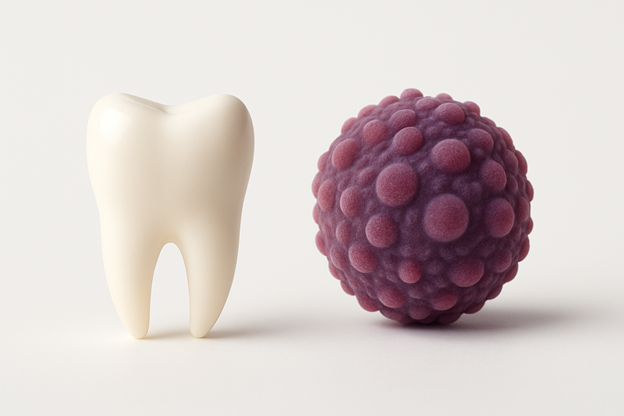
Cavities, Cancer, and the Great Biotech Revolt
Posted July 21, 2025
Chris Campbell
You brush, floss, rinse.
You buy the Waterpik and the new vibrating flosser for good measure. You chew the xylitol gum. You suck on those probiotic lozenges that taste like expired yogurt.
You even tried the “oil pulling” method you learned from a guy named River who lives in a van and brushes with charcoal.
And still, it happens…
Every few years, your dentist finds a “shadow” on the X-ray and suddenly you’re down $900 and one molar.
Why? Because the actual problem isn’t the plaque.
It’s the bacteria.
Your mouth is a battlefield.
And the enemy (called S. mutans) isn’t just surviving—it’s thriving.
Every time you feed it sugar, it produces acid. That acid drops the pH in your mouth and melts your enamel.
That’s how cavities happen.
You can brush all you want. But until you replace the enemy, it’s like fighting termites with a mop.
Fortunately, new technologies are rewriting what’s treatable and preventable…
And one treatment could be a dream come true for anyone who’s ever had the misfortune of a root canal.
Kill Cavities Forever?
They call it BCS3-L1.
A genetically modified strain of S. mutans that’s been reprogrammed.
It doesn’t turn sugar into acid. It turns it into alcohol. It doesn’t drill holes in your enamel. It just… hangs out. Peaceful. Friendly.
And—no less—it produces its own antibiotic that kicks out the rest of the bad S. mutans bugs like a billion tiny mouth bouncers.
It can’t mutate. It can’t share its genes. It can’t survive outside the human mouth.
And unlike full-spectrum antibiotics, it doesn’t kill everything in sight—it simply replaces the baddies with a better version of the same bacteria.
I learned about it in—of all places—a private clinic off the coast of Honduras. (Alas, it’s still technically illegal in the U.S. as a therapeutic treatment.)
But this is a great example of how technology is rewriting the rules, turning yesterday’s villains into tomorrow’s medicine.
And if we can reprogram a microbe to stop cavities forever…
Consider what happens when we reprogram something even smaller to target the greatest scourge of them all: cancer.
“There’s a Mass”
You’ve heard the stories…
The healthnut who eats clean, works out, drinks green sludge and subscribes to longevity newsletters.
And still—one day—he gets the call.
“There’s a mass.”
While diet, genetics, and environment seem to play a role…
The real issue: The body lost its ability to identify what doesn’t belong—and destroy it.
And modern treatment? Unfortunately, like root canals, we’re still swinging hammers at glass.
BUT…
What if we could deploy something that doesn’t attack the cancer directly… and instead shows your immune system exactly where it’s hiding?
Target Acquired.
Starting tomorrow, the U.S. might begin to see it in action.
Because the FDA is about to make a decision. Not just on some experimental drug… but on a whole new category of cancer treatment.
No chemo. No radiation. No immune suppression.
Just one engineered payload that has the potential to find the problem and stop it in its tracks.
This isn’t a marginal cancer drug—it’s among the first-ever living, programmable biologics cleared for FDA review. Approval would mark a major turning point in cancer treatment.
In fact, the results are so compelling that institutional investors now own 92.53% of the company’s shares—an almost unheard-of level of conviction in the biotech world.
(For context: a biotech company of this size typically sees 10–40% institutional ownership—maybe 60% if there’s serious buzz.)
And if the decision goes through tomorrow morning? This may be the moment biotech history splits in two: Before and After.
